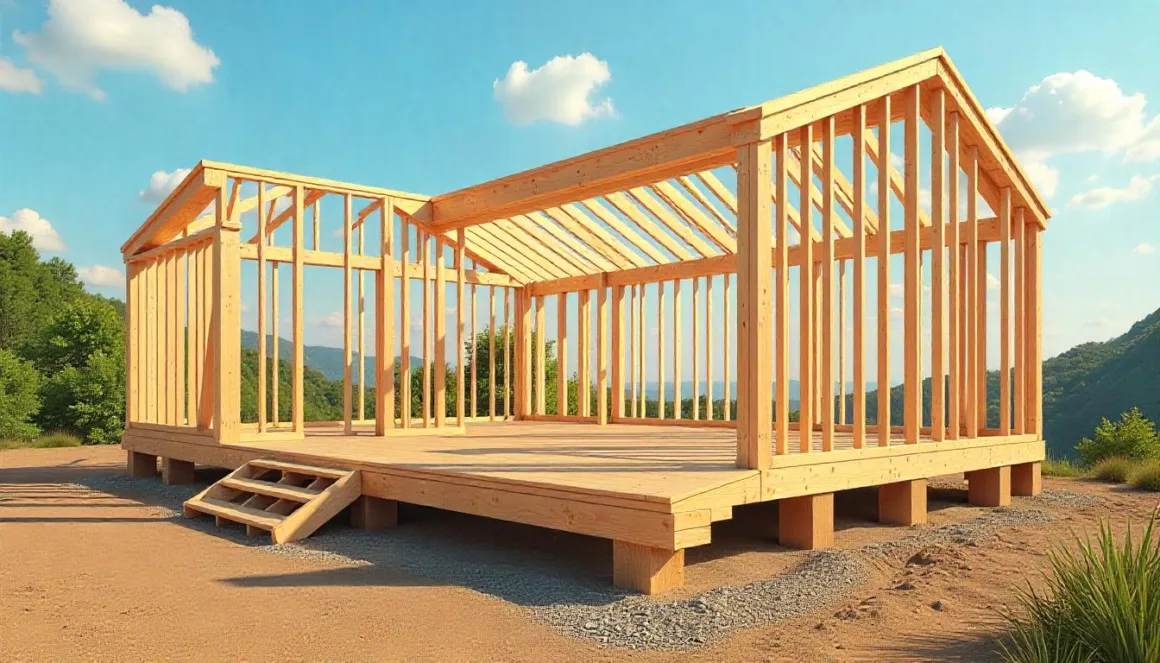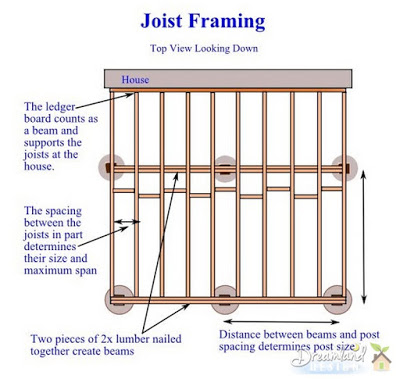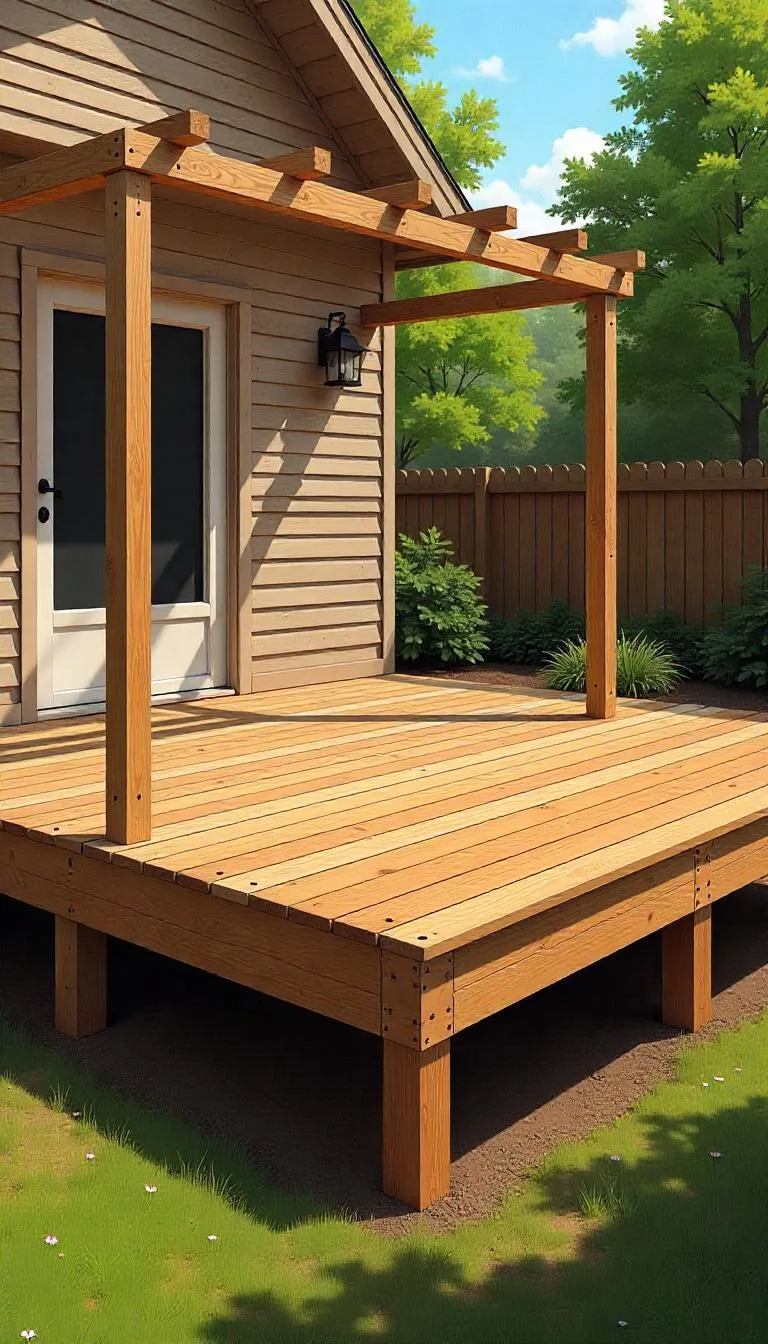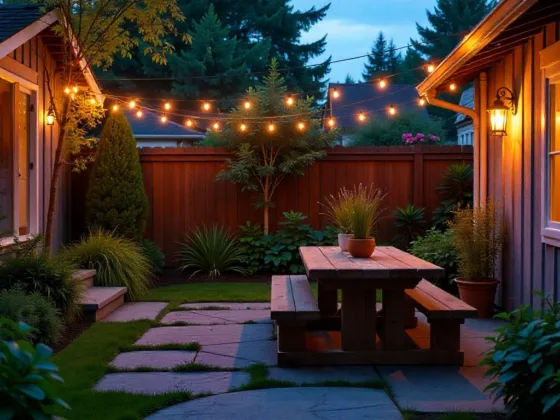Table of Contents Show
Starting with the size of your hardwood store lumber is just like any other woodworking project; it is really important. Like a jigsaw, this is vital to make sure all the parts match up perfectly.
Many others, meanwhile, could struggle with this assignment. Picking the right grade, kind, and size of wood is one of the biggest obstacles. Not only should you pay attention to proportions and aesthetic appeal but also pick wood that resists rain and weather conditions.
Do not, however, panic! Determining the right wood for decking doesn’t have to be difficult. Understanding the functions of several structural elements first will enable one to see how burdens are transmitted to the underlying foundations.
Check out our thorough guide to selecting deck framing timber if you need more detailed information on this issue.

Importance of Having the Appropriate Tools
Knowing how to choose the ideal timber opens another very important area of woodworking: having the right tools.
Having top-notch equipment is vital whether you’re a professional woodworker or someone who likes DIY projects; it helps you to produce amazing and visually pleasing works.
What tools do you require, though? How can you get them, though? This post will go over all you should know about woodworking tools, including:
- Essential hand tools every woodworker ought to own
- Must-have power tools for more efficient work
- Advice on getting tools without emptying the pockets
Therefore, before we get into the main argument, be sure to review our guide on woodworking tools and familiarize yourself with them.
How to Determine Deck Framing Lumber Sizes
Knowing Deck Framing Architecture
Supported by pillars and beams, a deck frame is a raised wooden platform. It comprises the next components:
- Joists: The deck’s primary framework consists of horizontal 2-by lumber.
- Beams: Horizontal supports carrying deck weight and transmitting it to the posts are beams.
- Posts: Vertical supports that carry the load to the footings and support the beams.
- Footings: Concrete foundations anchoring the posts to the ground.
Small Versus Large Deck Joist Framing
On a small deck, the beams are sometimes combined with the joist framework. This implies that the joists sit directly on top of the beams.
On bigger decks, nevertheless, beams are used under to support the joists individually.
Knowing Ledger Boards and Rim Joists
The outermost joists forming the deck framework’s circumference are the rim joists.
If the deck connects to a home or building, a ledger board takes the place of one of the rim joists. Fastened to the house frame, this board is the connection point for joining the deck to the structure.
Regarding size, the ledger board is normally composed of lumber of about the same size as the other joists (e.g., if you are using 2-by-8 joists, then use a 2-by-8 ledger board).
Constant Joist Sizing
Regarding selecting lumber sizes for your deck frame, most often it is best to keep things simple and consistent:
- All of your rim joists, ledger boards, and interior frame joists should be built using the same size lumber.
- Use 2-by-8 joists for the remainder of the frame if you choose to employ 2-by-8 joists for your ledger board or rim joists.
Knowing Joist Sizing
Your deck’s joists vary in size depending on two considerations:
- Spacing: Distances between joists.
- Length: The span of the joists from one end to the other.
The Smallest Joist Sizes
Typically, a 2-by-6 lumber is the smallest width for deck joists according to building codes.
- Spaced 12 inches apart, these 2-by-6 joists can cover up to 11 feet 7 inches without extra support.
- This means that using 2-by-6 joists may be appropriate and affordable if your deck is little with limited joist spans.
Variables Influencing Joist Dimensions
But for bigger decks with greater joist lengths, other considerations enter into play:
- Structural Integrity: Longer spans call for bigger and stronger joists to preserve structural integrity and avoid sagging.
- Additional Materials: Though initially less expensive, using smaller joists can result in more costs related to extra materials like joist hangers, screws, and concrete footings.
- Labor and Installation: Building a deck with lesser joists might also need more labor-intensive jobs such digging and putting more footings.
Using Joist Span Tables
Refer to joist span charts created just for several types of lumber to calculate the appropriate size for the joists of your deck depending on spacing and length.
Using a joist span table is shown here:
- Examine the accompanying chart created especially for southern yellow pine or like sturdy woods.
- Find the row that matches your required joist distance.
- Find the column that fits your joist length.
- The advised joist size results from the intersection of this row and column.
Sample Scenario
Let’s say you have the following deck specifications:
- Joist spacing: 16 inches apart
- Joist length: 12 feet (144 inches)
According to the joist span table, a 2-by-8 joist would be the ideal option since it can span up to 12 feet 10 inches at this spacing.
But if your joists were 15 feet long instead, then you would have to employ 2-by-10 joists that span up to 16 feet 5 inches.
Remember that with these longer spans, no further support under the joists is needed. By contrast, using less 2-by-6 joists would call for the addition of a beam with support posts and footings under it.
Gaining Insight into Beam Sizing and Post-Spacing
Supporting the deck’s weight and distributing it to the posts and ledger board, beams are absolutely vital.
Like joists, the dimensions of your beams are influenced by two elements:
- Joist Span: The length the beams will travel between supporting posts.
- Post Spacing: The distance between each post on the beam.
Minimum Beam Length
Under building codes, the smallest size for deck beams is often a double 2-by-6 arrangement. This implies attaching two pieces of 2-by-6 timber.
Factors influencing Beam Size
Consider these points when deciding the suitable beam size for your deck:
- Joist Span: Longer spans call for bigger beams to adequately support the joists and avoid sagging.
- Post spacing: Wider post distances allow for larger beams because there are less points of support.
Employing Beam Span Tables
Refer to beam span tables created particularly for various kinds of lumber to find the appropriate size for your deck’s beams based on joist span and post spacing.
An illustration of how to employ a beam span chart is given below:
- See the chart presented beneath, created for southern yellow pine or other similar strength woods.
- Locate the row appropriate for your specified joist length.
- Find the column with your post spacing.
- The recommended beam size will result from the intersection of this row and column.
Example Scenario:
- Joist span: 10 feet
- Post spacing: 8 feet
According to the beam span table, you have two alternatives:
- Use a 4-by-8 beam with posts spaced 8 feet apart.
- Use a 4-by-12 beam with posts spaced 12 feet apart.
Particularly if you require many beams for the layout of your deck, the decision between these two is important.
Using the 4-by-12 beam on a large deck will relieve you of the time and cost of pouring more foundations and putting in more posts. Should the height of your deck permit it, this might also make available extra open below for a patio or storage area.
Know Post Sizing and Placement
Essential elements of the construction of your deck, posts offer vertical support for the beams and distribute the weight on the footings.
Two elements will determine the size and positioning of your posts:
- Beam Size: The joist span and post spacing determine the size of your beams.
- Deck Height: The elevation of your deck’s surface relative to the ground.
Post Spacing and Beam Size
The length needed between posts is determined by the size of your beams:
- Posts for a 4-by-10 beam supporting a 12-foot joist span should be spaced no more than 9 feet.
- Two posts would be enough for correct support if your beam is approximately 9 feet long.
- Three posts are required to guarantee stability if your beam is 12 feet long.
Post Sizing and Deck Height
The height of your deck over ground level also affects the size of your posts:
- 4-by-4 posts are suitable for decks less than six feet high.
- Decks over 6 feet call for robust 6-by-6 posts.
Using Post Sizing Diagrams
Based on beam size and deck height, post-sizing charts made particularly for various load regions will help you to find the right size for the posts on your deck.
One illustration of how to utilize a post-sizing chart follows:
- Check the graph below, especially constructed for southern yellow pine or comparable strength woods.
- Calculating the load area by multiplying the distance between beams by the spacing between posts.
- Ascertain whether the height of your deck is 6 feet or higher or under.
- The advised post size will come from the related value in the chart.
Example Scenario
- Beam spacing: 10 feet apart
- Post spacing: 6 feet apart
Given the criteria specified, you may determine the load area by multiplying the post spacing (6 feet) by the beam spacing (10 feet), therefore yielding 60 square feet.
Then, measure the height of your deck. You could use 4-by-4 posts if it is less than 6 feet. But you would need stronger 6-by-6 posts for more stability if it is 6 feet or more.
Consult the post-sizing chart for southern yellow pine or comparable strong timbers. Find the load area value of 60 square feet and find the relevant suggested post size according on the height of your deck.
By following these instructions, you can guarantee the structural soundness and safety of your deck by post of the right size and spacing being used.
Choosing the Best Lumber Type
Choosing the suitable type of lumber for your deck also has much to do with selecting the lumber size. Generally speaking, the following groups best represent the kinds of wood employed in deck building:
- Pressure Treated Lumber, which is usually pine or fir. To make them highly heat-resistant, chemicals are applied to these. Warm nations would therefore find this perfect. Although this kind of wood is also the cheapest, exercise extra care when selecting to make sure the material you receive is loose knots-free.
- Naturally Resistant Species, which can usually be cedar, redwood, and cypress. These are insect-resistant and rot-resistant. Before using the wood to construct your deck, you can seal or stain it to preserve the tree source’s natural beauty. Meranti, cambara, or Ipe are excellent alternatives if your budget allows more costly but also more durable choices.
Arrangement of Everything
Although it first seems too much, in reality it is rather simple. Choose your deck’s size.
1. Find the least supported joist lumber for the deck’s dimensions.
2. Determine beam kinds, post spacing, and post sizes.
Estimating deck construction expenditures begins with choosing the timber.
Let’s consider two case studies.
Deck One: 24 x 10 feet
There is no need to use 2-by-10s for joists if the deck only protrudes 10 feet from the house.
- According to the Deck Joist and Joist Sizing Chart, 2-by-6 joists on 16-inch centers will span 9 feet 9 inches.
- Our joists measure just 9 feet 7 1/2 inches. For the ledger thickness, we include 1 1/2 inches; another 3 inches for the rim joist to serve as our beam. This takes the overall span to ten feet precisely. 2-by-6 joists are therefore accessible for us.
Then, let’s determine the optimal beam size with the fewest footings that can support the deck. Given our joist span of 10 feet, we can calculate that a:
- a 24-foot-long beam
- 4-by-12 dimensions
Our joists will be supported by this beam with 12-foot centers.
We require:
- 3 posts
- 3 footings
They should be arranged as follows:
- A left-side post on the deck
- One post in the middle, 12 feet apart from each end.
- One right-sided post
Two elements influence the size of these posts:
- The section of loading
- The level of the deck
The posts are 12 feet apart in this instance; the beams are 10 feet apart (ledger to beam = 10 feet).
Therefore, our loaded region is:
10 x 12 = 120 square feet
The graph shows that whatever the height of the deck, six-by-six posts are still necessary.
Deck Two: 12 x 12 feet
According to the joist chart, a 2-by-8 joist spanning 12 feet can be accomplished without any extra mid-level support.
- Because we don’t need a center support beam, one beam along the front of the deck will suffice.
Based on the Deck Beam and Post Spacing chart:
- Post spacing for a 4-by-8 beam supporting a 12-foot joist span should not exceed 7 feet.
- For our 12-foot width, we may employ three posts and footings spaced 6 feet apart on a 4-by-8 beam.
Our load area is 6 x 12, or 72. Based on this:
- We should use 6-by-6 posts for decks taller than 6 feet.
- For decks less than 6 feet, we may use 4-by-4 posts.
Final Thoughts
A deck is a wonderful addition to any home, especially when it offers a beautiful view of your garden. It is like having an outdoor room perfectly integrated with your interior living area.
Depending on your taste, you can personalize your deck: design a comfortable seating area, cover it with rich green plants, or even convert it into an outdoor entertainment center with a TV and speakers for movie nights under the stars. Simply protect your devices from rain and dust!
Keep in mind, though, that fashionable deck furniture might lure undesired guests like birds and animals that see your deck as their new hangout. Consider employing expert bird control companies to drive them away instead of turning to extreme solutions like removing them yourself.
Furthermore, if you frequently have visitors over, your deck may function as a friendly gathering place for you and them. Considering all of these elements, the advice given above ought to enable you to design a well-designed and practical deck.
Note: Choosing the correct type and dimension of wood forms the basis of a great deck. This guarantees that you are building something meant to last. Thus, confidently set out on your deck-building adventure!
FAQs (Frequently Asked Questions)
2×6, 2×8, 2×10, and 2×12 are among the typical sizes for deck framing timber. These figures reflect the nominal size of the wood prior to it being dried and planed, therefore the actual dimensions would be marginally smaller.
Think about local building codes, the load the deck would bear, and the distance between supports while selecting the appropriate size of wood. Larger spans typically call for bigger timber sizes to guarantee safe and adequate support.
Treated wood is chemically treated to withstand rot, decay, and insect damage, so making it suitable for outside use. Unless it is appropriately sealed and cared for, untreated lumber is not resistant to these factors and is often not advised for deck frame.
The kind of decking material and the size of the wood used usually guide joist spacing. For 2×6 joists, a customary spacing is 16 inches on center; for 2×8 or larger, 24 inches on center might be suitable. For particular needs, always check with local building codes.
Although building codes change with location, they usually address issues including lumber size, spacing, and supporting needs. Before beginning your deck framing project, it’s imperative to confirm with your local building agency compliance with all requirements.

















1 comment
One of the best archery related blogs I’ve seen in some time